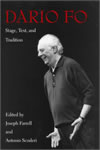 |
 |
 |
 |
![]()
Volume 6,
Issue 3, Spring 2003
|
Dario Fo: Stage, Text, and Tradition Farrell, Joseph, and Antonio Scuderi (Editors)Southern Illinois University Press, 2000 222 pages Hardcover: US $40.00} |

|
Reviewed by: LaDonna
Ryggs, Bob Jones University
Printer-friendly PDF
version
Editors Farrell and Scuderi pull together an international team of experts—all the contributors have experienced Fo either through previous publishing or personally working with him. Throughout the book there is a sustained sensitivity to the actor/author, Fo, whose craft intermingles politics with laughter, storytelling with medieval "reinvented" history, and a return to "dangerous theater," not to be confused with avant-garde or modern theater, which Fo abhors. The editors tell the story of a man who has been "one of the most influential figures in twentieth century theater." His ability to combine ancient and medieval influence with commedia dell’arte and even Western comedy practices has produced successful political farces that as Fo said "do not leave the audience laughing, but with unreleased anger." He believes that in acting or in writing, there was no "luxury of moral neutrality."
The book is a collection of essays dealing with Fo’s place in history, his phases, and his politics. Fo considers himself a popular Marxist, allowing for a cultural and not just an economic interpretation to Marxism. This approach, as noted by Jennifer Lorch, a contributor, makes it difficult, if not impossible, for Westerners to truly appreciate Fo’s works because of the dialectical political cultures. The title itself is a comment on the actor/author and the irony of a man considered revolutionary, yet who tenaciously clung to theatrical traditions and age-old forms of medieval theater—the jester, the discussion play, and the morality play—each form riddled with political and religious overtones.
The book ingeniously crosses the interdisciplinary divide, providing insightful reading in sociology, philosophy, feminism, music, drama, storytelling, and language. Fo’s dramatic interplay between dialect and physicality, monosyllabic utterances and stage presence, text and the "living" audience, and the politics of storytelling make for a fascinating study. The chapter dealing with Fo and his wife, Franca Rame’s portrayal of women’s issues is indicative of material feminism with some twists. Rame tries to come to grips with her own femininity on stage in a heterosexual, monogamous way through the approach of comedy, but leaving the audience with the distinct realization that what they are witnessing is a tragedy.
For upper-level college acting, storytelling, and interpretation courses, this book would be very effective. For students who compete in forensics, and those who coach them, the book could prove beneficial in helping the student to establish a unique stage presence, physicality, understand language usage and sounds and their relationship to the whole of presentation, characterization in the light of storytelling, examine alternative roles of comedy and how to apply them, as well as a provide a glimpse into international theater.
For graduate level courses, the worthwhile rhetorical conversations that could be entered are numerous and varied—written versus performed text, textual analysis, the role of "audience" in traditional theater, the creation of "others" in a dramatic situation, material versus radical feminism on the stage—what it looks like, how it effects, and even the reinvention of tradition for the sake of political exploitation. The research sources at the end of each chapter would create ample opportunity for in-depth analysis, and the book contains a wealth of these sources. Perhaps this text could be used in interdisciplinary discussion as an example of communication in theory, practice, politics, and everyday life. If so, this book would have proved valuable indeed.
Back to Top
Home | Current
Issue | Archives | Editorial
Information | Search | Interact